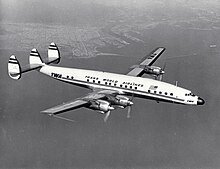Commercial transport

The Lockheed Constellation was an American civil airliner and military transport built in the 1940s and 1950s; this is a list of its variants. The aircraft was used for many roles, including one variant Columbine II becoming the first Air Force One. More commonly used for troop or cargo transport everywhere from Vietnam to Antarctica, there was also specialized variants for electronic warfare or with different engines such as turboprops.








